Microgeneration of Electricity in Gyms—A Review and Conceptual Study
Abstract
1. Introduction
2. Microgeneration of Electricity Using Human Physical Activity
2.1. Human Performance Capabilities and Generated Energy
Pmec = 0.20 · 837.5 W = 167.5 W
Pel = 0.75 · 167.5 W = 125.6 W
Eel = 125.6 W · 1800 s = 226,080 J = 62.8 Wh
- -
- Changes in muscle coordination—disturbances in the synchronization of the work of individual muscle groups.
- -
- Metabolic changes—accumulation of metabolites, such as hydrogen ions (H⁺), in the muscle environment.
- -
- Neurological factors—reduced recruitment of motor units by the nervous system.
- Mathematical Model of Fatigue (Exponential)
- Operating Model (Threshold)
- Energy Systems and Physiological Determinants of Performance
- Anaerobic glycolysis: activated in the range of 10–90 s of high-intensity exercise [28].
- Aerobic system: dominant during efforts lasting more than 90 s, constituting the main source of energy during long-term activity.
2.2. Examples of Constructions and Solutions for Devices Generating Electricity
- Stationary bicycles with a generator
- Treadmills with a recuperation system
- Rowing machines with a generator (rowing ergometers)
- Kinetic Floor Systems
- Specialized strength equipment
3. Training and Diagnostic Device for Generating Electrical Energy
- -
- analysis of the volume of water in the body: maintaining a healthy level of water ensures the effective functioning of the body, reduces the risk of health problems, and limits the risk of lifestyle diseases. Maintaining a consistent and healthy percentage of water in the body is key to maintaining the body’s balance and health;
- -
- analysis of the mass of adipose tissue (kg): a high level of adipose tissue can contribute to the occurrence of lifestyle diseases, including hypertension, heart disease, diabetes, or cancer;
- -
- analysis of the muscle mass (kg): protein is the main element of limb muscles, intestinal muscles, and skin. With the increase in muscle mass, the demand for energy increases, which helps to reduce adipose tissue and body weight in a healthy way;
- -
- analysis of the content of bone and boneless mineral substances (kg): the development of muscle tissue is associated with strengthening bones. It is important to maintain healthy bones through a balanced diet and physical exercise,
- -
- BMI analysis: the ratio of body weight to height; determining the body mass index is important in assessing the risk of diseases related to overweight and obesity, e.g., diabetes, ischemic heart disease, and atherosclerosis. An increased BMI value is associated with an increased risk of such diseases;
- -
- systolic and diastolic blood pressure values: blood pressure is the pressure of flowing blood on the walls of the arteries. Its value depends primarily on the efficiency of the heart, the width of the vessels, and the elasticity of their walls. To determine this level, systolic and diastolic blood pressure is measured. Abnormal pulse pressure can contribute to the development of atherosclerosis and other circulatory system diseases.
- -
- pulse: the undulating movement of the arteries, which depends on the contractions of the heart, but also on the elasticity of the artery walls (e.g., their response may be weaker if it is hindered by atherosclerotic changes). The importance for health includes its frequency (the perceptible number of beats per minute), regularity (the intervals between beats and their strength should be the same), and symmetry (the perceptible pulse on the right and left sides of the body should be the same).
- -
- blood oxygen saturation values: the percentage of hemoglobin in the blood bound to oxygen measured using the pulse oximetry method, primarily to counteract and prevent respiratory failure;
- -
- tissue thermography recording: physiological features of the human body related to warm-bloodedness and tissue emissivity in the mid-infrared range make the human body an excellent object in thermographic studies. Visualization of the temperature distribution on the surface of the human body provides valuable diagnostic information and is mostly a reflection of the processes occurring inside the body (including inflammation).
- the user’s biological parameters (pressure, pulse, saturation, body composition)—data sent to the monitoring system to adjust the load to physiological capabilities; and
- electrical and mechanical parameters of the generator (current, voltage, rotational speed, power)—data used to optimize the converter’s operation and analyze training effectiveness.
- dynamic measurement of advanced body parameters during actual physical effort;
- diagnostics supporting the prevention and treatment of circulatory system diseases and lifestyle diseases;
- collection and analysis of training data through a dedicated application;
- generation of electrical energy for the needs of the device and the possibility of transferring the surplus to the grid;
- electrical load-setting system controlled by a microprocessor monitoring system based on biological and technical data;
- full compatibility with various types of training devices.
4. Energy Storage and Management Systems in Energy-Efficient Sports Facilities
4.1. Electricity Storage Technologies
- Electrochemical storage devices—galvanic cells (battery storage devices): they are among the most frequently implemented energy storage technologies in various commercial applications, including prototype and commercial fitness devices generating energy. Among the available battery types, lithium-ion (Li-ion) batteries are particularly popular due to their high energy density (NMC—nickel–manganese–cobalt) and relatively high cyclic efficiency (G–NMC—graphene–nickel–manganese–cobalt), typically 85–95%. Other technologies, such as lead–acid (PbA—lead–acid), lithium iron phosphate (LFP), and lithium–titanium (LTO) batteries, also find their application niches, offering unique compromises between cost, service life, and operating characteristics. A significant advantage of battery storage is the potential for integration with inverters (DC/AC converters) and advanced energy management systems (EMS), enabling precise control of the charging and discharging process.
- Electric storage—supercapacitors (ultracapacitors): they offer unique properties in terms of very fast charging and discharging, which makes them particularly attractive in applications requiring short-term energy pulses, such as those generated during intensive training intervals. They are also characterized by exceptionally long life (50,000–1,000,000 cycles) and high resistance to multiple work cycles compared to traditional batteries. Their energy density is usually lower (5–10 Wh/kg) than that of lithium-ion batteries (100–260 Wh/kg), which limits their use to systems with smaller storage capacity.
- Mechanical storage (flywheels): the principle of operation of this technology is based on storing kinetic energy in a rotating massive element. This technology, which is in the development phase, is used in some experimental installations, where positive features such as high power (up to 200 kW), fast energy release, high efficiency (89–95%), and durability (1,000,000 cycles) are used.
- Smart grid V2G/V2B (vehicle-to-grid/vehicle-to-building) technologies: they represent a future-oriented approach to energy storage in sports facilities, assuming integration with electric vehicles (EV) belonging to gym users. As part of this concept, electric car storage could act as mobile energy storage, returning the stored energy to the grid or building during periods of increased demand or to stabilize the local microgrid. However, the implementation of this technology requires the development of an appropriate bidirectional charging infrastructure and energy management systems capable of coordinating energy flows between vehicles and the building.
4.2. Intelligent Energy Management Systems (EMS)
- real-time energy monitoring: EMS track and analyze energy usage in different areas of the gym, including lighting, ventilation systems, mobile device charging, and other loads. Detailed consumption data allows for the identification of areas with the greatest potential for savings;
- energy production prediction: based on the group class schedule, projected user numbers, and historical data, EMS can predict the amount of energy that will be generated by training equipment during specific time periods;
- load prioritization: EMS allow for defining priorities for different energy consumers. In the event of limited energy availability, the system can automatically direct it to the key loads such as backup power, energy-efficient LED lighting, or IT systems, ensuring the continuity of the critical infrastructure;
- energy storage control: EMS play a key role in optimally managing the charging and discharging cycles of energy storage systems. Control algorithms decide when energy should be stored and when it should be fed back into the internal grid, depending on the current and projected demand profiles;
- integration with multiple energy sources: advanced EMS can integrate with other on-site renewable energy sources, such as photovoltaic (PV) systems, small wind turbines, and the external utility grid (enabling on-grid and potentially off-grid operation in the event of a power failure);
- data collection and reporting: EMS collect detailed data on energy production, consumption, and storage, enabling reporting on the facility’s energy efficiency and tracking carbon dioxide (CO2) emissions. This information is crucial for monitoring progress toward sustainability goals and identifying further optimization opportunities.
5. Discussion
6. Conclusions
- Humans can generate significant amounts of mechanical energy, which—using effective conversion technologies—can be used to produce electricity for local needs.
- The energy efficiency of users is determined by physiological factors (age, gender, level of training, VO2 max, HR max), as well as environmental conditions and effort characteristics.
- Mathematical models describing fatigue and the dynamics of human energy systems enable realistic forecasting of the microgeneration potential.
- The developed training and diagnostic device effectively integrates the functions of energy generation, dynamic diagnostics, and load personalization thanks to the use of a microprocessor supervision system and an electrical load-setting system.
- Integration of devices with energy storage and intelligent management systems enables effective use of the generated energy and increases the autonomy and energy efficiency of sports facilities.
- Microgeneration technologies are important not only for energy, but also for education and health, supporting the promotion of an active lifestyle and ecological awareness of users. Solutions of this type, despite energy limitations, are a significant step towards sustainable development, and further technological and system improvements can increase their importance in future energy systems.
- Preliminary economic analysis shows that while the payback period based solely on energy savings is relatively long (29–45 years), the device provides significant added value through diagnostics, smart training control, and data monitoring. When applied in commercial environments with subscription-based services, the return on investment can be achieved within one year. Furthermore, integration with intelligent energy management systems may allow such devices to contribute to overall building energy efficiency, particularly in the context of net-zero energy or smart building strategies.
Author Contributions
Funding
Conflicts of Interest
References
- David, A.K.; Wen, F. Transmission planning and investment under competitive electricity market environment. In Proceedings of the 2001 Power Engineering Society Summer Meeting. Conference Proceedings (Cat. No. 01CH37262), Vancouver, BC, Canada, 15–19 July 2001; Volume 3, pp. 1725–1730. [Google Scholar] [CrossRef]
- Fernandez, M.I.; Go, Y.I.; Wong, D.M.; Früh, W.-G. Review of challenges and key enablers in energy systems towards net zero target: Renewables, storage, buildings, & grid technologies. Heliyon 2024, 10, e40691. [Google Scholar] [CrossRef] [PubMed]
- Torto, S.O.G.; Pachauri, R.K.; Singh, J.G.; Khan, B.; Ali, A. Networked micro-grid topologies for transactive energy management system: An overview and future perspectives. Sci. Afr. 2024, 26, e02488. [Google Scholar] [CrossRef]
- Rossi, M.; Lingkang, J.; Monforti Ferrario, A.; Di Somma, M.; Buonanno, A.; Papadimitriou, C.; Morch, A.; Graditi, G.; Comodi, G. Energy Hub and Micro-Energy Hub Architecture in Integrated Local Energy Communities: Enabling Technologies and Energy Planning Tools. Energies 2024, 17, 4813. [Google Scholar] [CrossRef]
- Hassan, Q.; Algburi, S.; Sameen, A.Z.; Salman, H.M.; Jaszczur, M. A review of hybrid renewable energy systems: Solar and wind-powered solutions: Challenges, opportunities, and policy implications. Results Eng. 2023, 20, 101621. [Google Scholar] [CrossRef]
- Rohracher, H.; Velkova, J.; Magnusson, D.; Farhangi, M. Re-assembling infrastructures from below. The agency of households in the sustainable energy transition. Environ. Innov. Soc. Transit. 2025, 54, 100943. [Google Scholar] [CrossRef]
- Hwang, J.; Kim, J.; Yoon, S. DT-BEMS: Digital twin-enabled building energy management system for information fusion and energy efficiency. Energy 2025, 40, 136162. [Google Scholar] [CrossRef]
- Ciccozzi, A.; Santavicca, A.; de Rubeis, T.; Ambrosini, D. BIM-BEM interoperability for energy analysis: A comparative study of different strategies. Energy Rep. 2025, 13, 4705–4718. [Google Scholar] [CrossRef]
- Sebestyén, V. Renewable and Sustainable Energy Reviews: Environmental impact networks of renewable energy power plants. Renew. Sustain. Energy Rev. 2021, 151, 111626. [Google Scholar] [CrossRef]
- Reitman, M. Energy Generator Powered by Gym Facility. U.S. Patent US 13/844,705, 18 September 2014. [Google Scholar]
- Madhup, K.; Mundada, G.S. Energy Harvesting from Gym Equipments. Int. J. Innov. Res. Electr. Electron. Instrum. Control. Eng. 2017, 5, 127–131. [Google Scholar] [CrossRef]
- Polish Press Agency SA. ECO-POWR™—An Idea for a Gym Powered by Human Muscle Energy. Available online: https://www.pap.pl/mediaroom/970664%2Ceco-powrtm-pomysl-na-silownie-zasilana-energia-ludzkich-miesni.html (accessed on 21 April 2025).
- Mechtenberg, A.R.; Borchers, K.; Miyingo, E.W.; Hormasji, F.; Hariharan, A.; Makanda, J.V.; Musaazi, M.K. Human power (HP) as a viable electricity portfolio option below 20W/Capita. Energy Sustain. Dev. 2012, 16, 125–145. [Google Scholar] [CrossRef]
- Gowrabathina, R.; Naperla, V.S.; Thottempudi, S.V.; Udatha, V.; Srinivasa, R.S.; Shafee, S.M. Design and Fabrication of Power Generation System by using Gym Equipment. Int. J. Multidiscip. Res. IJFMR 2023, 5, 1–13. [Google Scholar] [CrossRef]
- Ayush, S.; Mrugendra, K.; Yash, W.; Snehal, K. Generation of Electricity From Gyming Equipments. Int. J. Sci. Adv. Res. Technol. 2021, 593–597. [Google Scholar]
- Divyansh, T.; Mudit, S.; Abhishek, K.; Dhruv, K.; Ashutosh, S. Energy Generation From Gym Equipment: A Review. Int. J. Sci. Adv. Res. Technol. 2019, 168–171. [Google Scholar]
- Sunil, H.V.; Sujeet, S.; Shivakumar, R.; Suman, R.A.S.; Arun, K.M. Power Generation using Gym Equipment. Int. J. Latest Eng. Res. Appl. 2019, 40–47. [Google Scholar]
- Patil, R.N.; Dhanke, J.; Bhavar, H.; Momin, S.; Patil, H.; Redekar, A.; Dadge, A.; Phadatare, N.; Pawar, P. Eco-Friendly Electricity Generation Via Gym Equipments. Eur. Chem. Bull. 2023, 685–697. [Google Scholar] [CrossRef]
- Mahendhar, M.; Mehraj, A.; Yadav, E.D.; Reddy, K.L.; Sainath, K. Power Generator Forearm Machine. Int. J. Creat. Res. Thoughts 2022, 10, h333–h337. [Google Scholar]
- Bonde, V.S.; Khatake, B.V.; Zambare, D.V.; Patel, V.D.; Kadam, N.V. Electric Power Generation from Gym Equipment with Polarity Checker and Changer Circuit. Int. J. Sci. Res. Dev. 2017, 992–995. [Google Scholar]
- Bhandari, A.; Itte, S.; Jangipuria, J.; Harayan, R. Power Generation Using Gym Equipment. Int. Res. J. Eng. Technol. 2019. [Google Scholar]
- Kumar, D.P.; Pothirahes, R.; Ajamal Hasan, P.; Sanjay, V.; Kumar, P.; Sathish, P. Power Generation By Gym Pull Up. Int. Adv. Res. J. Sci. Eng. Technol. 2024. [Google Scholar] [CrossRef]
- Liu, M. Man Powered Gyms: ReRev Green Gyms Turn Kinetic Energy into Electricity. Available online: https://www.trendhunter.com/trends/rerev-green-gyms (accessed on 2 May 2025).
- González-Alonso, J.; Quistorff, B.; Krustrup, P.; Bangsbo, J.; Saltin, B. Heat production in human skeletal muscle at the onset of intense dynamic exercise. J. Physiol. 2000, 524, 603–615. [Google Scholar] [CrossRef]
- Scott, K.P.; Edward, T.H.; John, Q. Exercise Physiology: Theory and Application to Fitness and Performance; McGraw Hill/Medical: New York, NY, USA, 2023; ISBN 9781259870453. [Google Scholar]
- Hargreaves, M.; Spriet, L.L. Author Correction: Skeletal muscle energy metabolism during exercise. Nat. Metab. 2021, 2, 990. [Google Scholar] [CrossRef] [PubMed]
- Hargreaves, M.; Spriet, L.L. Skeletal muscle energy metabolism during exercise. Nat. Metab. 2020, 2, 817–828. [Google Scholar] [CrossRef] [PubMed]
- Lawrence, L.S. Anaerobic Metabolism During Exercise. In Exercise Metabolism. Physiology in Health and Disease; McConell, G., Ed.; Springer: Cham, Switzerland, 2022. [Google Scholar]
- Ozemek, C.A. ACSM’s Guidelines for Exercise Testing and Prescription; Wolters Kluwer: Alphen aan den Rijn, The Netherlands, 2025; ISBN 9781975219208. [Google Scholar]
- David, L.C.; Jack, H.W.; Kenney, W.L. Physiology of Sport and Exercise; Human Kinetics: Champaign, IL, USA, 2021; ISBN 9781718201729. [Google Scholar]
- Ashfaq, A.; Cronin, N.; Müller, P. Recent advances in machine learning for maximal oxygen uptake (VO2 max) prediction: A review. Inform. Med. Unlocked 2022, 28, 100863. [Google Scholar] [CrossRef]
- Jade, M. Get Fit and Generate Energy from These Innovative Electricity Generating Bikes. Available online: https://www.ecorenewableenergy.com.au/articles/change-the-world-one-workout-at-a-time-eco-powr-spin-bikes (accessed on 2 May 2025).
- ECO-POWR™—Eco-Friendly Gym, Fitness Equipment That Produces Electricity—SportsArt. Available online: https://sportsartfitness.pl/green-system/ (accessed on 2 May 2025).
- Precision Fitness Equipment. SportsArt G545R ECO-POWR Recumbent Cycle—Precision Fitness Equipment. Available online: https://www.precisionfitnessequipment.com/product/sportsart-g545r-recumbent-cycle (accessed on 2 May 2025).
- G690 Verde—Treadmill. Available online: https://sportsartfitness.pl/green-system/g690/ (accessed on 25 May 2025).
- Texas State University Home to World’s Largest Human Power Plant | ABC13 Houston | abc13.com-ABC13 Houston. Available online: https://abc13.com/archive/7186214/?utm_source=chatgpt.com (accessed on 28 May 2025).
- Kashem, S.B.A.; Majid, M.E.; Tabassum, M.; Iqbal, A.; Pandav, K.; Abdellah, K. A Comprehensive Study and Analysis of Kinetic Energy Floor. Acta Energetica Power Eng. Q. 2020, 2, 6–13. [Google Scholar] [CrossRef]
- Invest in Pavegen. Available online: https://invest.pavegen.com/ (accessed on 2 May 2025).
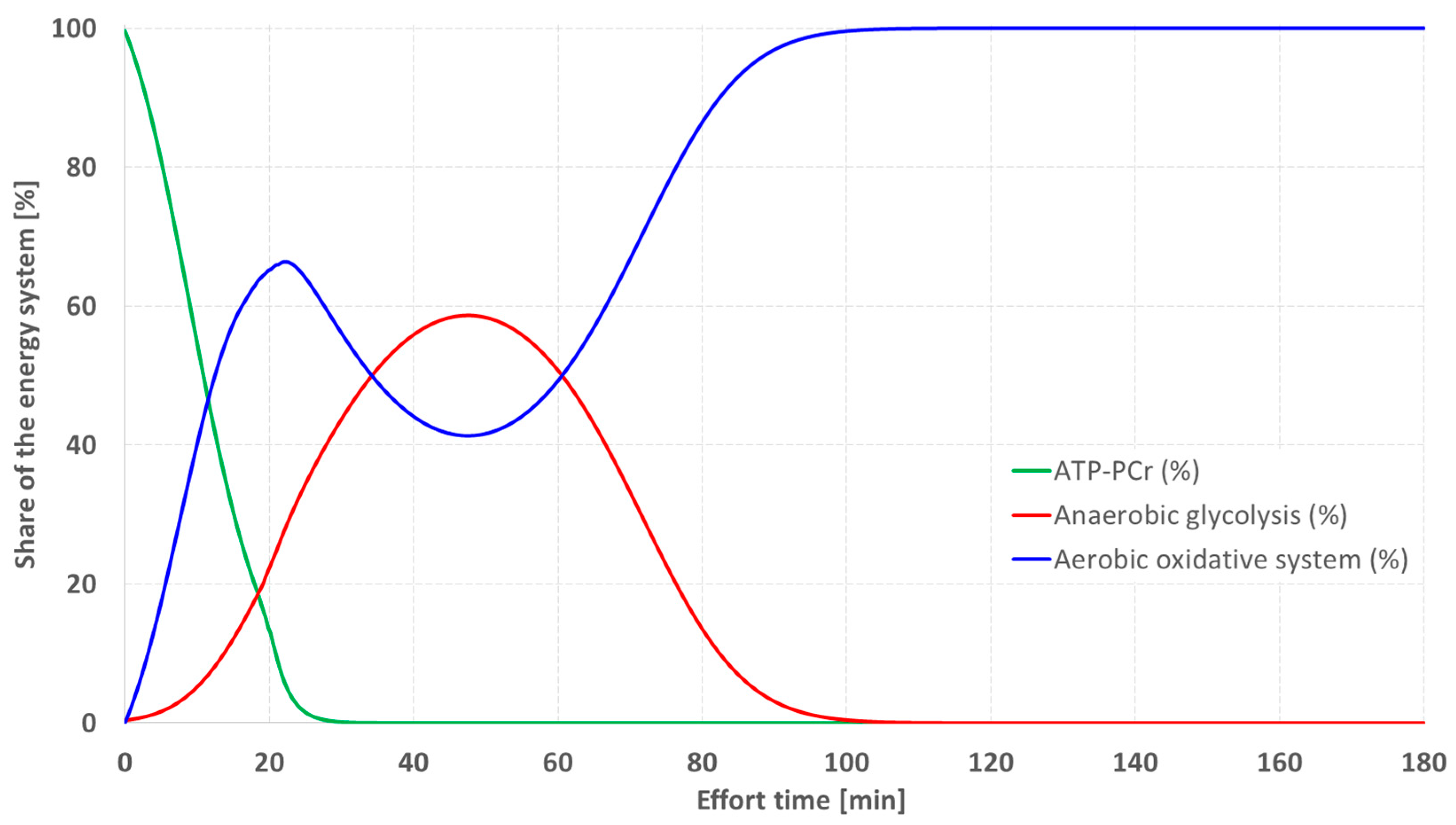
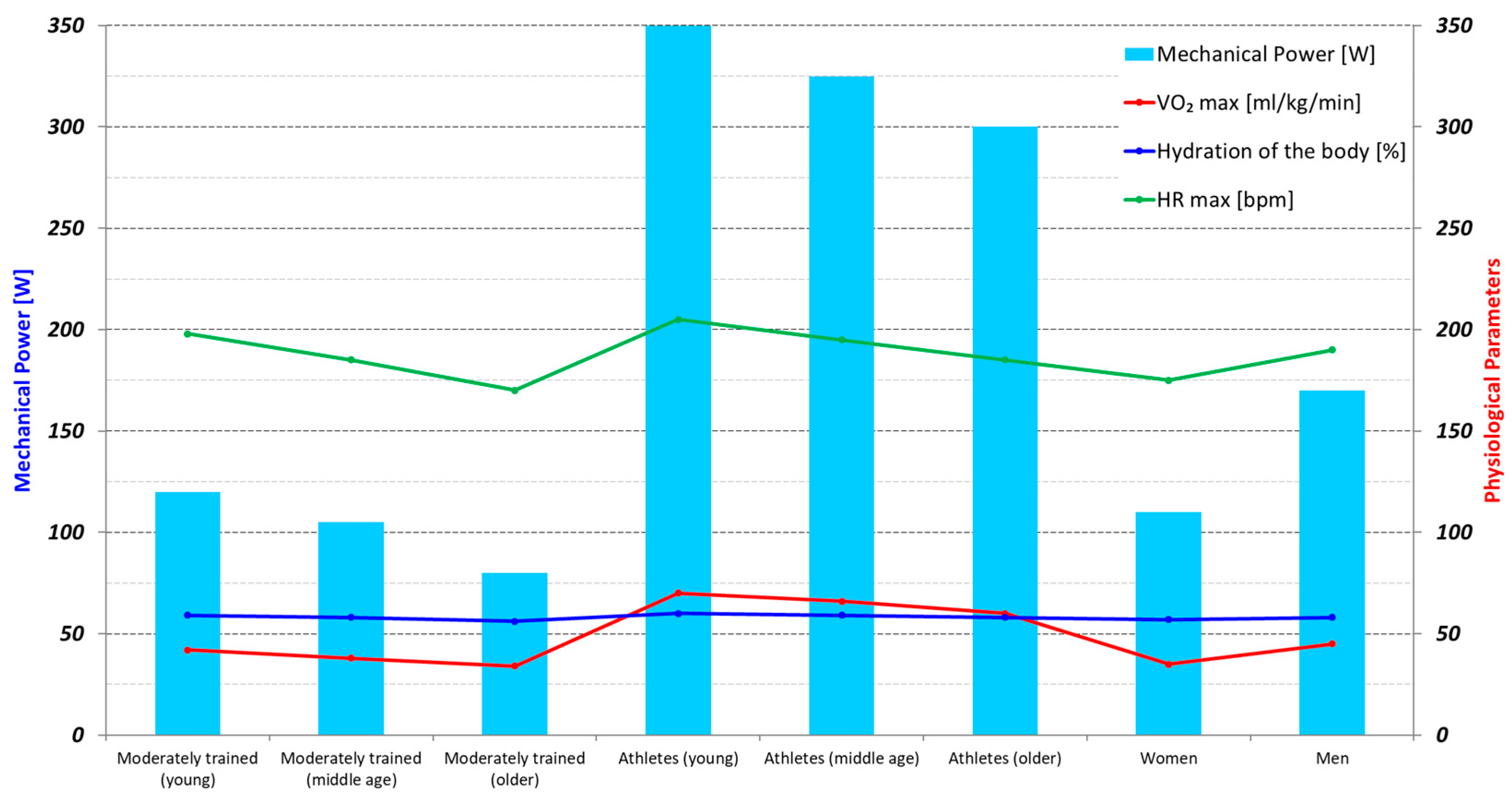

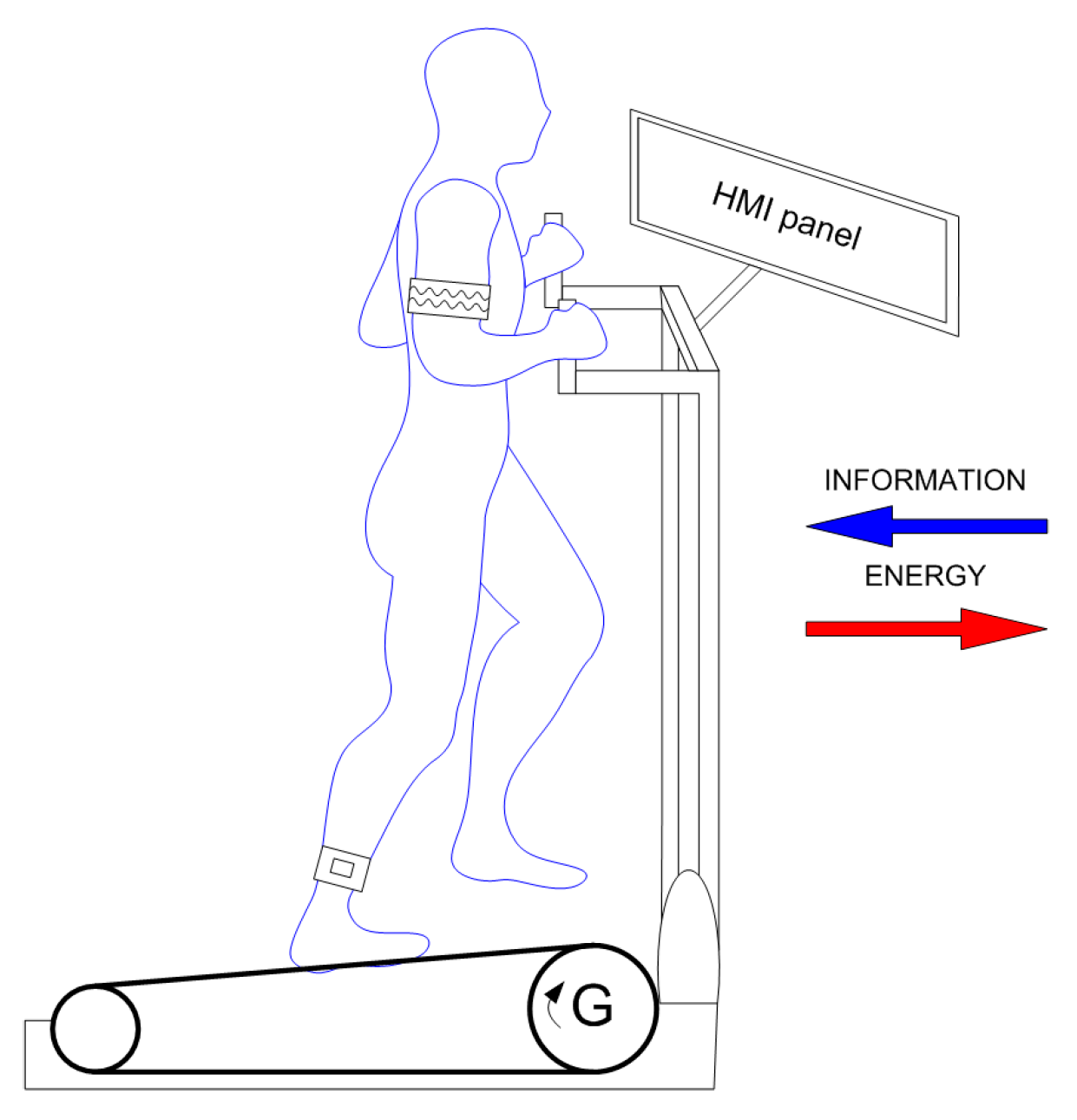
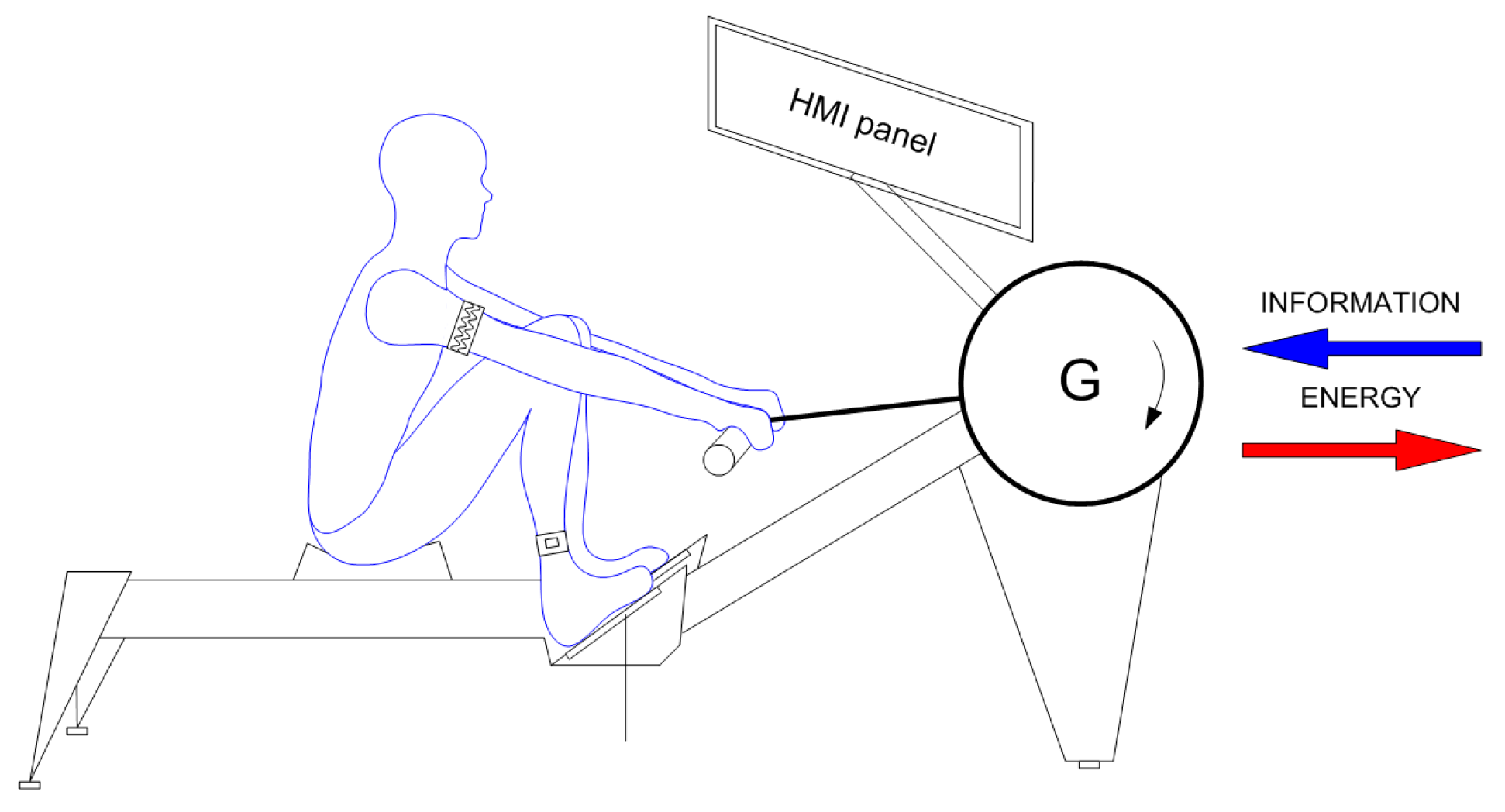
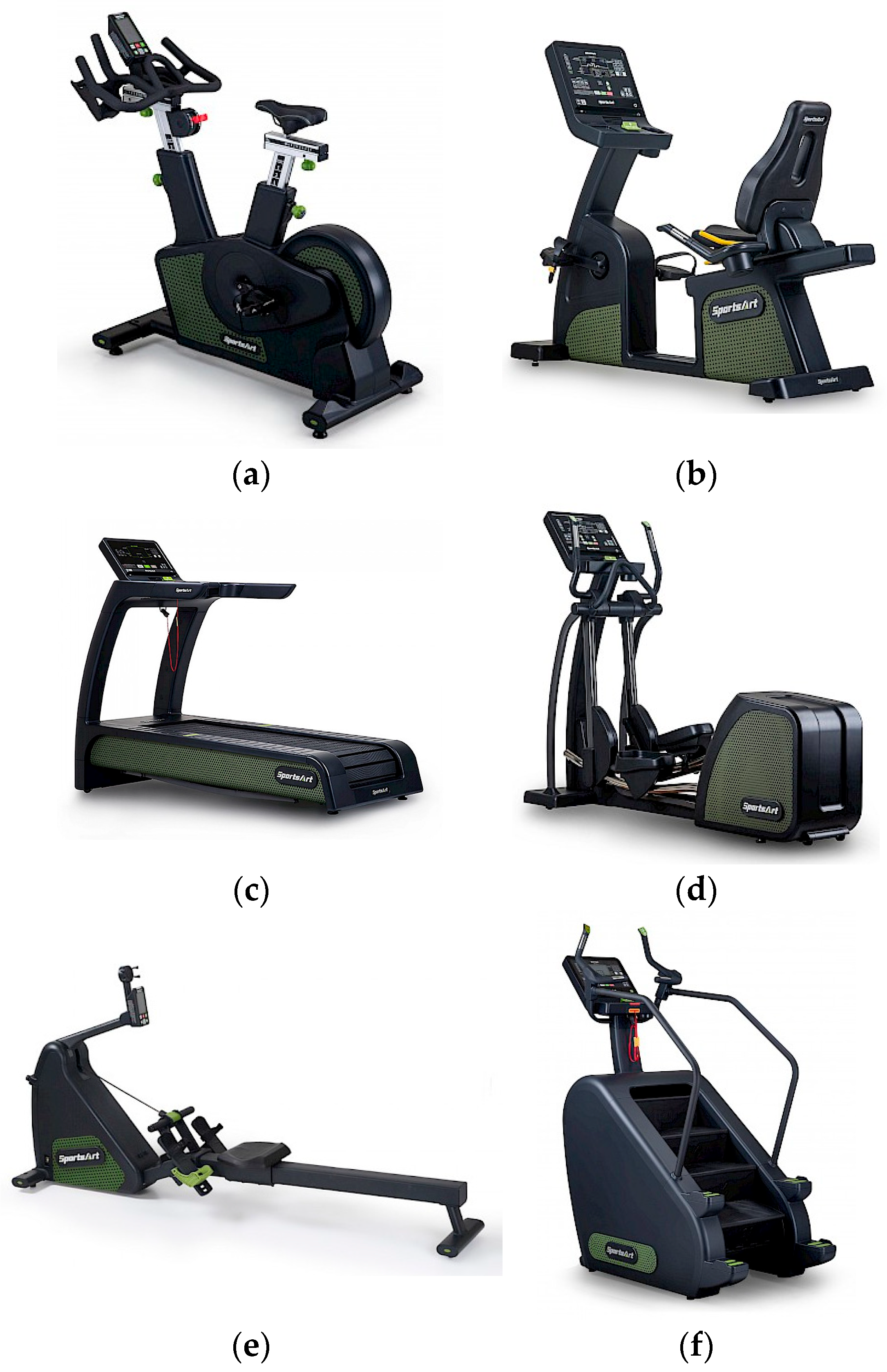
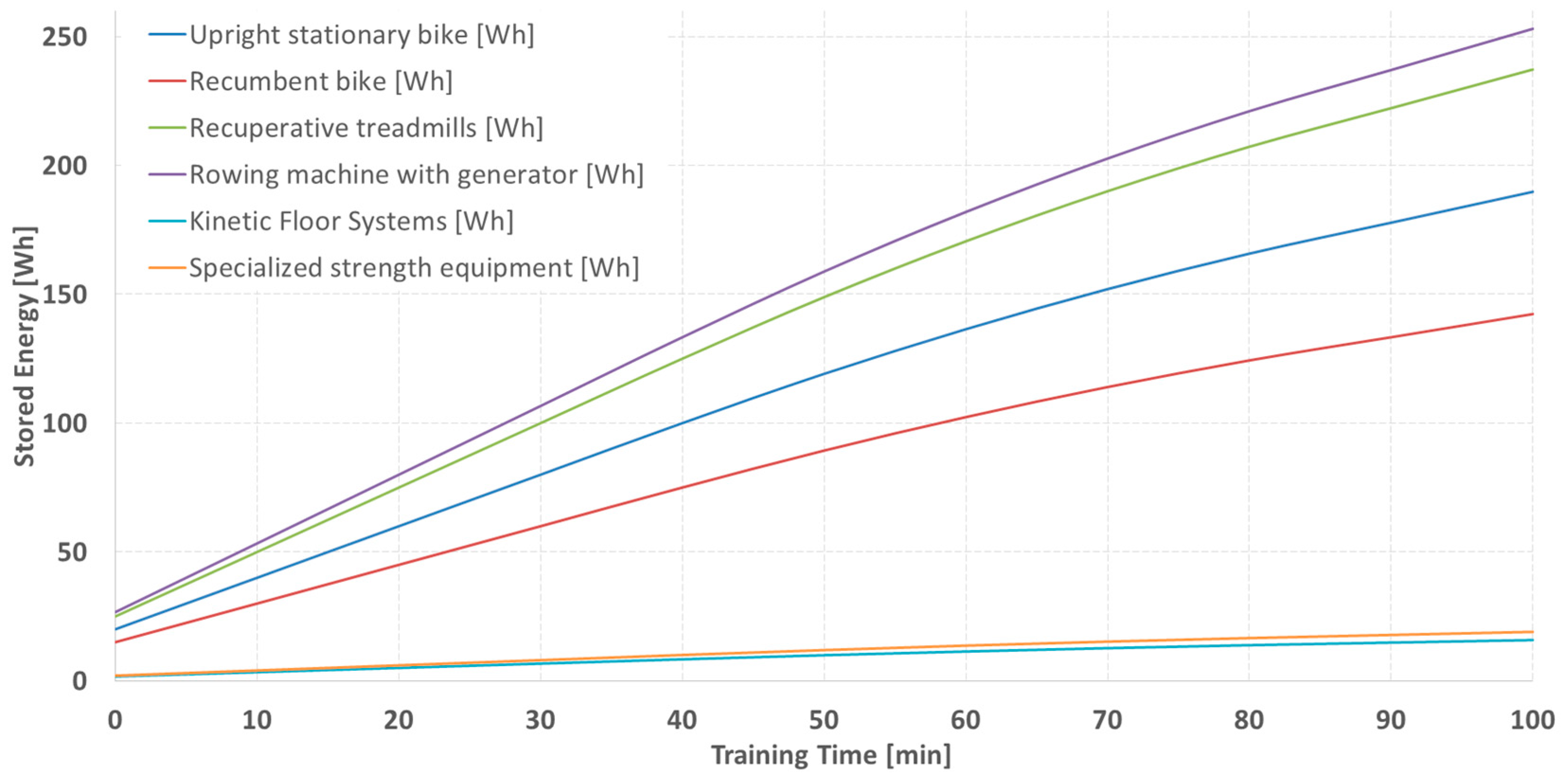
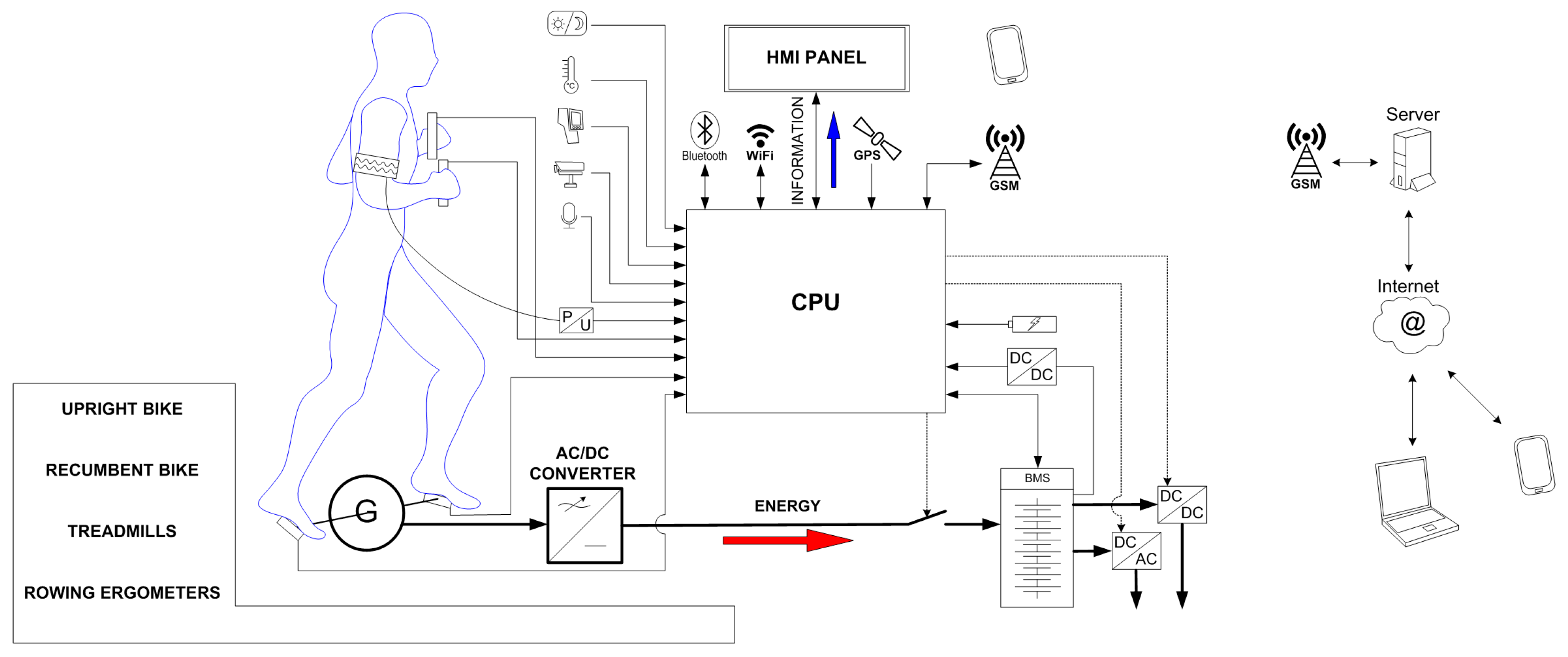

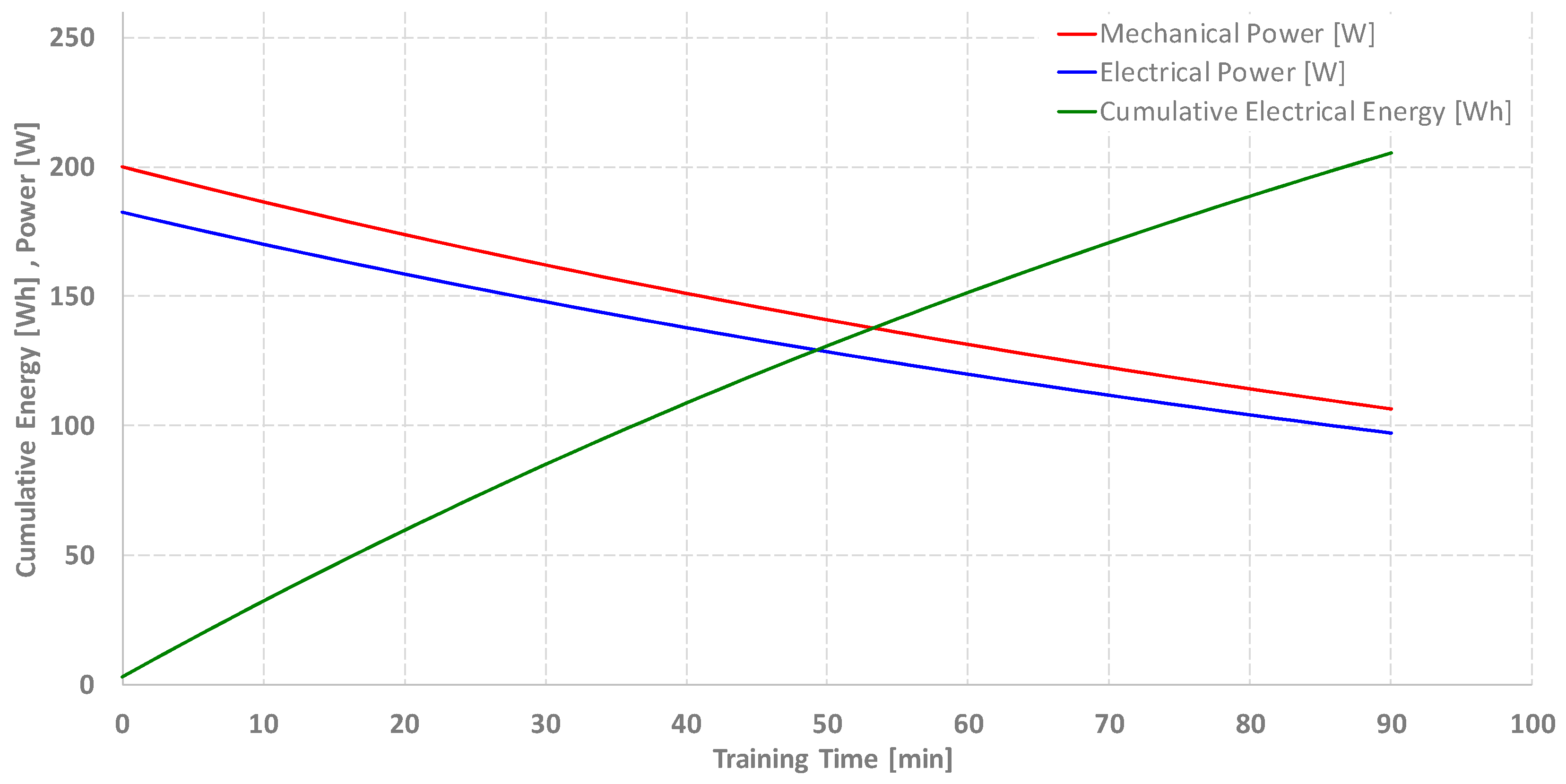
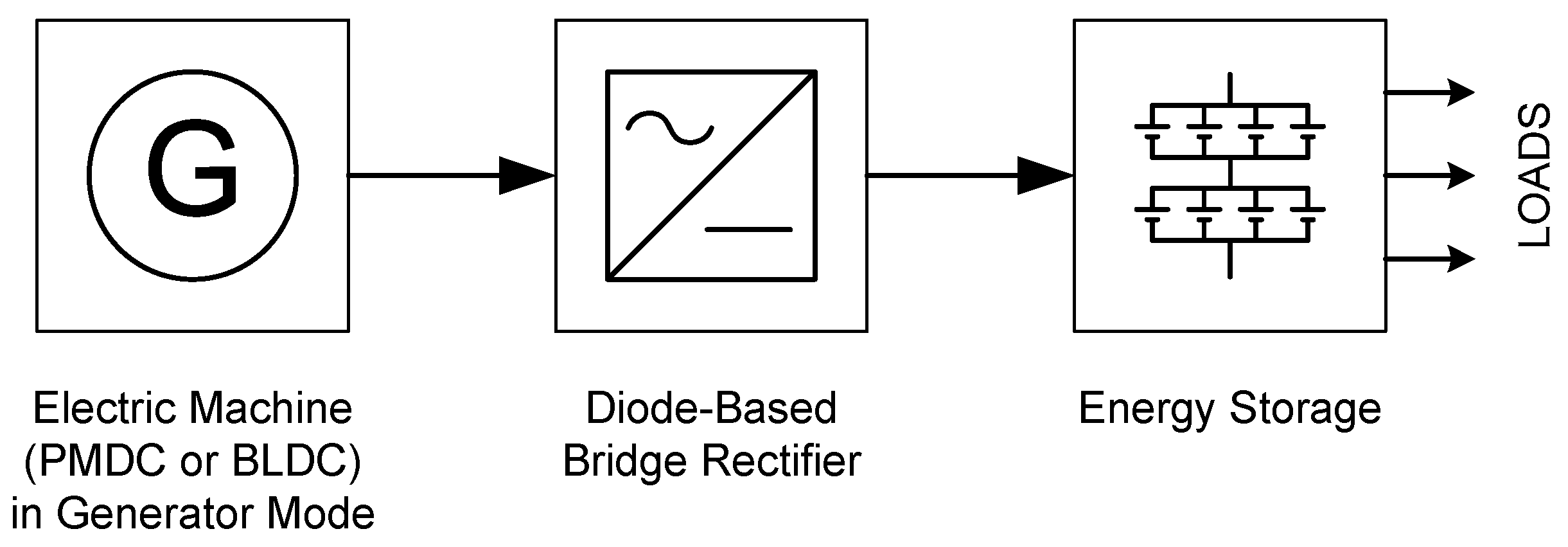

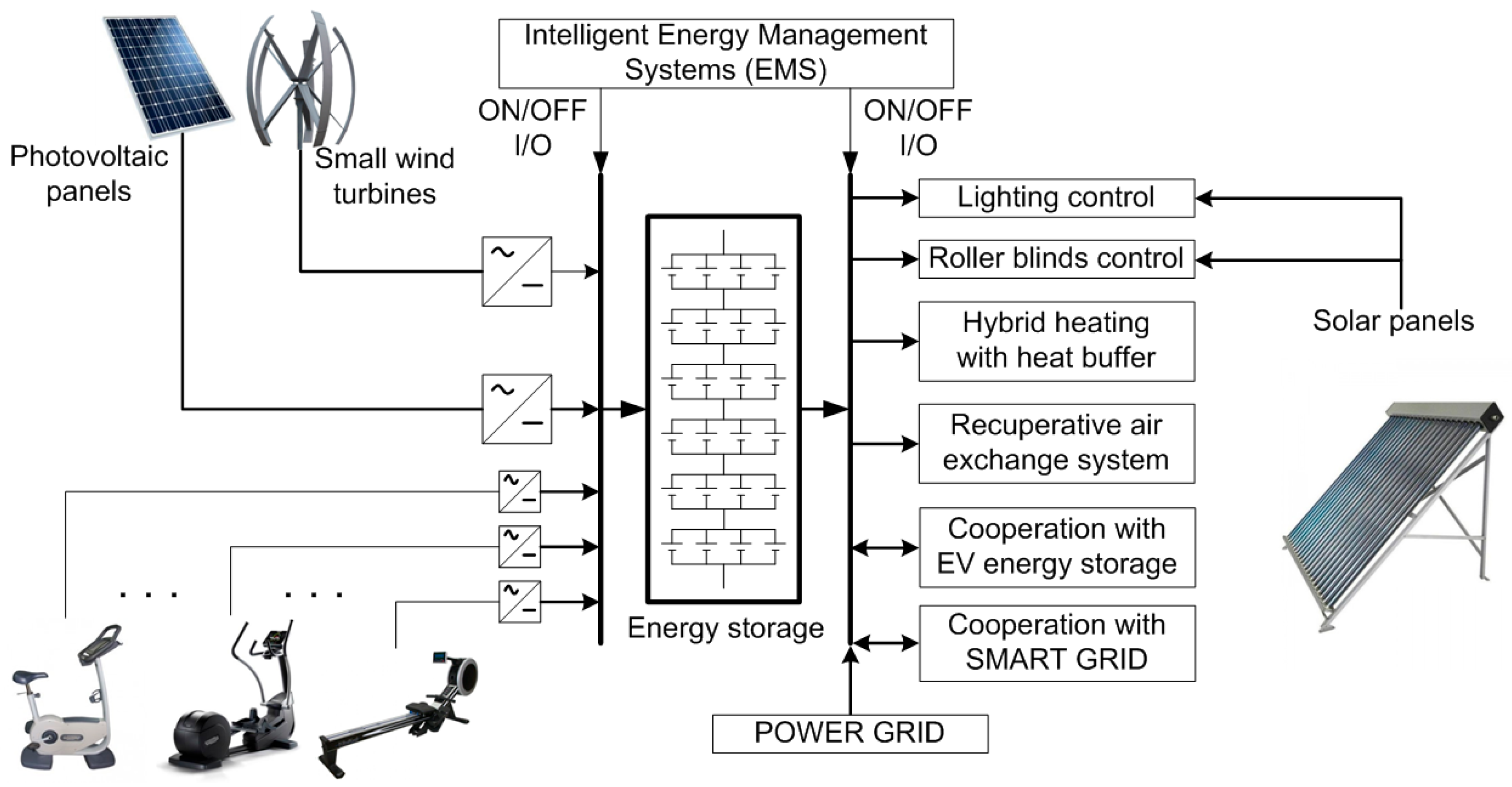
| Device Type | Power Generation Potential [W] | Estimated System Efficiency [%] | Commercial Availability | Integration with EMS/Smart Grid | Dynamic Load Adaptation | Use of Vector Control/MPPT |
|---|---|---|---|---|---|---|
| Upright bicycle | 100–250 | 70–80 | High (e.g., SportsArt, ReRev) | Yes (basic) | No | No |
| Recumbent bicycle | 80–180 | 65–75 | Medium | Limited | No | No |
| Rowing machine | 150–300 | 70–85 | Medium | Limited | No | No |
| Elliptical trainer | 100–250 | 70–80 | High (e.g., SportsArt G876) | Yes (selected models) | No | No |
| Strength equipment | 20–100 | 50–70 | Low | No | No | No |
| Kinetic floor systems | 10–50 | 30–60 | Low | No | No | No |
| Proposed system (PMSM + active rectifier) | 100–300 | ~90 | Prototype/conceptual | Yes (programmable, bidirectional) | Yes | Yes |
Disclaimer/Publisher’s Note: The statements, opinions and data contained in all publications are solely those of the individual author(s) and contributor(s) and not of MDPI and/or the editor(s). MDPI and/or the editor(s) disclaim responsibility for any injury to people or property resulting from any ideas, methods, instructions or products referred to in the content. |
© 2025 by the authors. Licensee MDPI, Basel, Switzerland. This article is an open access article distributed under the terms and conditions of the Creative Commons Attribution (CC BY) license (https://creativecommons.org/licenses/by/4.0/).
Share and Cite
Moska, W.; Łebkowski, A. Microgeneration of Electricity in Gyms—A Review and Conceptual Study. Energies 2025, 18, 2912. https://doi.org/10.3390/en18112912
Moska W, Łebkowski A. Microgeneration of Electricity in Gyms—A Review and Conceptual Study. Energies. 2025; 18(11):2912. https://doi.org/10.3390/en18112912
Chicago/Turabian StyleMoska, Waldemar, and Andrzej Łebkowski. 2025. "Microgeneration of Electricity in Gyms—A Review and Conceptual Study" Energies 18, no. 11: 2912. https://doi.org/10.3390/en18112912
APA StyleMoska, W., & Łebkowski, A. (2025). Microgeneration of Electricity in Gyms—A Review and Conceptual Study. Energies, 18(11), 2912. https://doi.org/10.3390/en18112912







